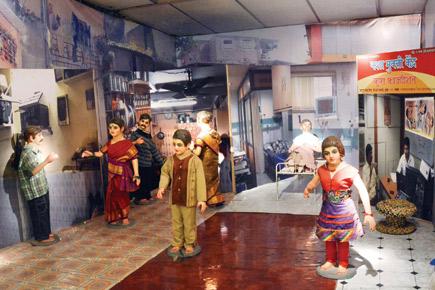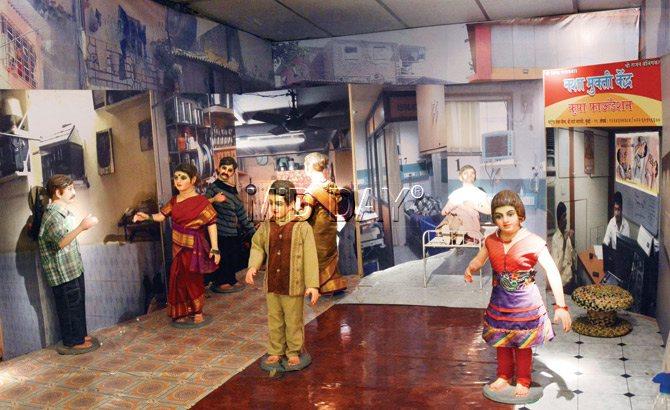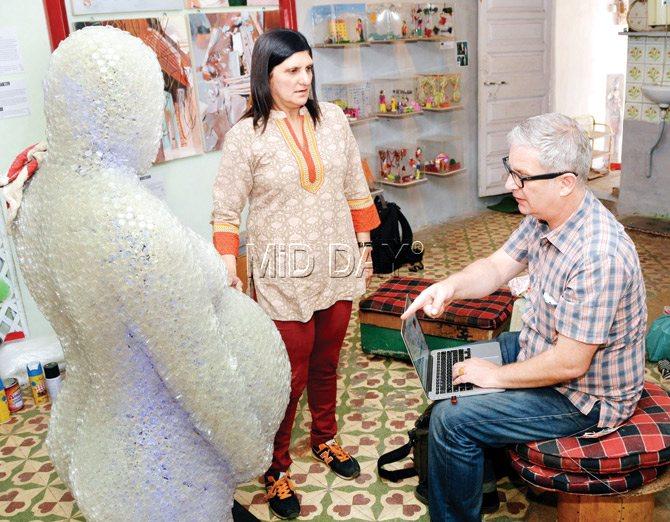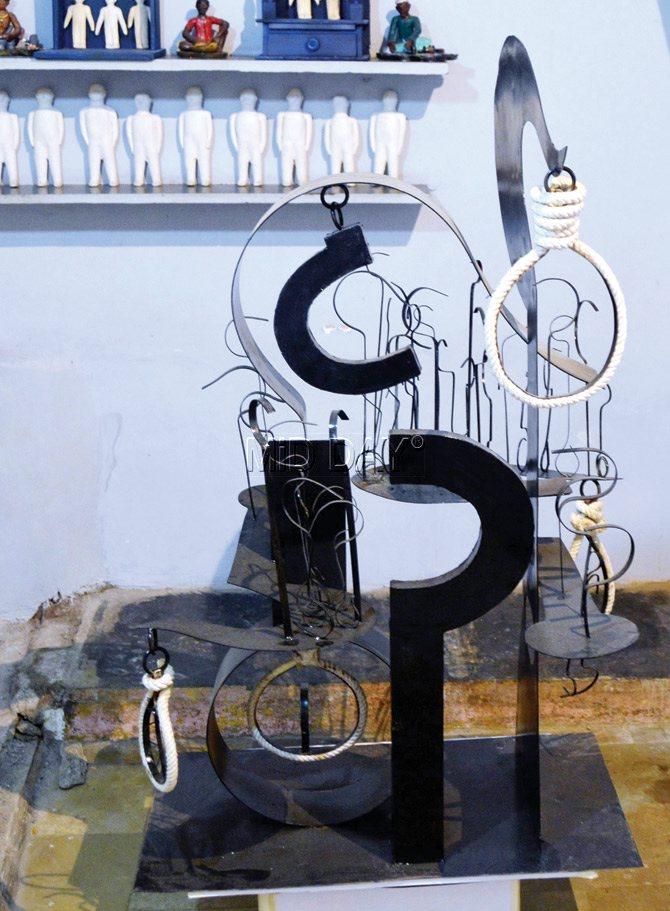This weekend, head to the Dharavi Biennale to gauge how local artisans and simple ideas on health and social issues are helping create awareness within the community

A skit on the perils of alcohol abuse features a tableau with moving figures at the Dharavi Biennale. Pic/Sayed Sameer Abedi
![]() In February 2015, when David Osrin and Nayreen Daruwalla of local non-government organisation SNEHA (Society for Nutrition, Education and Health Action), along with UCL Institute of Global Health and Institute of Global Health and Wellcome Trust, held the inaugural Dharavi Biennale, it covered four venues in Dharavi, and received a footfall of over 10,000. The exhibition featured artworks by local artists under the mentorship of various established artists, highlighting health and social issues plaguing the residents of the area.
In February 2015, when David Osrin and Nayreen Daruwalla of local non-government organisation SNEHA (Society for Nutrition, Education and Health Action), along with UCL Institute of Global Health and Institute of Global Health and Wellcome Trust, held the inaugural Dharavi Biennale, it covered four venues in Dharavi, and received a footfall of over 10,000. The exhibition featured artworks by local artists under the mentorship of various established artists, highlighting health and social issues plaguing the residents of the area.

A skit on the perils of alcohol abuse features a tableau with moving figures at the Dharavi Biennale. Pic/Sayyed Sameer Abedi
"The first time we exhibited the work done with local artistes, it was on a small scale, and we called it Dekha Andekha. It was held in a school and was successful. Due to the positive response, we thought of doing it again. Two years later, our fund-raisers, the Wellcome Trust, said that we had to up the scale. So, we felt why not call it a biennale like the Venice or the Kochi Biennale. It was a joke but also a statement that prodded: ‘Why not have a biennale in Dharavi?’ The difference between Venice’s edition and this one is that in most other places, artists are invited and they create their works while here, it is created by those people who belong to the area," Osrin tells us.

David Osrin (right) and Nayreen Daruwalla with an exhibit featuring 4,000 medicine bottles at the Colour Box office in Dharavi. Pics/ Sayyed Sameer Abedi
While taking a cover off one of the installations that’s still wrapped in plastic, Osrin says, "We host many health-related programmes, and so, we felt that art was a great way to spread awareness about such issues. The art programme doesn’t run instead of the regular methods that we use but runs alongside, and is a part of what we do. Many participants have told us that they learnt more through these programmes as they created the art themselves, and hence, the concepts sank in better," he reasons.

The Anti-Tobacco exhibit: An exhibit created using packets of tobacco to show the perils of consuming it
What's new?
This time, the exhibition will feature additional artists who heard about the biennale from other artists who had previously worked with the NGO. When we walked into the Colour Box office at Dharavi’s 90 Feet Road, Daruwalla who was prepping up with exhibits for D-day greeted us warmly. Our eyes veered towards a display that included safety boxes highlighting places that women found safest; women between 20 and 50 years have created these. This included places like a kitchen, a Math class and a garden, among others. A new installation by local artist Sunanda Chavan looks at stress. She has depicted the questions that arise in one’s head when one is tense and shows how that leads people to commit suicide. A group of women have embroidered the brain and created clay models of it too.

The safety deposit box installations: Safety boxes created by women showcase places and areas that they found safest
"We showed them functional MRI scans of people who had been shown an emotional visual. Different parts of the brain light up when it is being used and gets highlighted in the scan. The artists recreated the idea in the installation," she says, reminding us midway that these artists have had no formal training.
Local artist Vandana Koli’s earlier exhibit used 4,000 medicine bottles to depict that a woman must consume lots of medicines, including folic acid and calcium, during pregnancy. She raises a valid question — since birth is an organic and natural process, why drug the woman? It was appreciated from all quarters.

The stress buster: An installation that highlights how stress in urban life leads people to commit suicide
This time, Koli has created a new piece that was aided by a scholarship, awarded by SNEHA to candidates from Dharavi who have been shortlisted on the basis of an application and an interview. It is based on the candidate’s artistic talents, their leadership qualities and their ability to interact with a group. Koli has created a hollow man using tobacco packets that shows how he is melting from inside due to its consumption. A bunch of young adults are also creating puppets and will perform a show about mental health, using the Vikram and Betal story from the Panchtantra, at the inauguration.
See and believe
A few selected exhibits from last year will also be on display, including pots made by Kumbharwada artisans, who had participated in an art workshop in February last year, that discussed sexually transmitted diseases. The biennale will also display a few photographs of an activity held after the Delhi student’s rape in 2012. These portray some of Dharavi’s women with sarees bearing slogans like ‘lock up rapists and not rape victims.’ The women who are dressed as superheroes wear eye masks in the photographs. Also on display will be comics created by teens about various subjects, which were published as a book later, and a quilted map showcasing areas where volunteers had witnessed gender based violence.
Apart from programmes that help women who have faced violence, SNEHA also features programmes that educate women about having a baby, nutrition of children, family planning work, sexual and reproductive health, all of which involves extensive community activity. "Earlier, NGOs had traditional methods of engaging communities. These do-and-learn workshops work better than listening. Now, women ask many questions to doctors because they were involved with the creation of the art," recalls Daruwalla, adding that when they’ve taken part in such projects, they are more likely to be interested in participating in the other sessions.
"Women who were part of the safety box workshop are now our sanginis (partners) and volunteers for a programme where they use smartphones and identify areas with high rate of gender related violence," she tells us before heading to fix the sound for the audio-visual tableau that needed a dekko. "That’s Dharavi — things work, and then, in a moment, they don’t," she smiles.
 Subscribe today by clicking the link and stay updated with the latest news!" Click here!
Subscribe today by clicking the link and stay updated with the latest news!" Click here!









